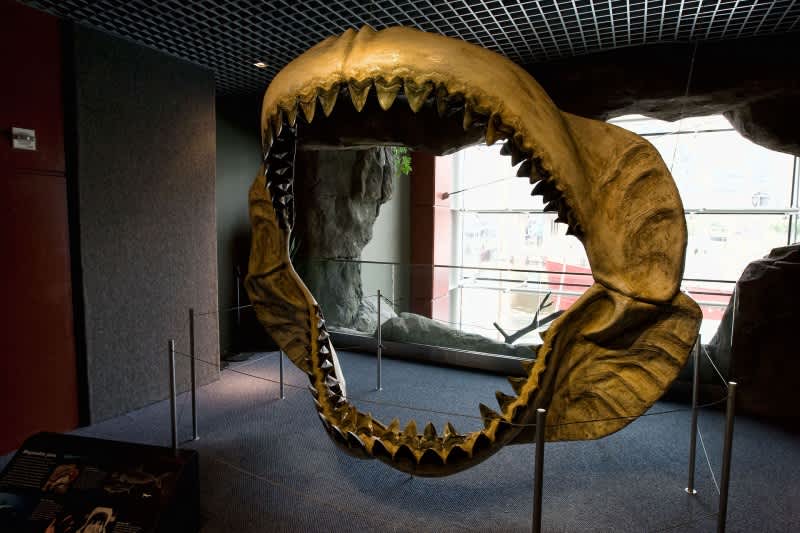5 Prehistoric Fish They Don’t Make Rods Big Enough For
Daniel Xu 11.18.15

Forget the rods and forget the lures, you’re not going to be catching these behemoth fish anytime soon. Due to the popularity of our articles on large ancient deer and bears, we decided to do one on fish as well. All the species on this list are already extinct, but you’d likely have a hard time catching these fish even if they weren’t.
What kind of line would you need for these massive fish?
1. Dunkleosteus terrelli (the armored giant)

We’re not really sure exactly why this massive fish actually required armor. Not only did it grow up to 33 feet long and clock in at a good four tons, this apex predator also boasted the strongest biting power of any fish ever. In fact, it was so powerful that scientists suspect that it routinely bit ancient sharks in half.
Four-hundred million years ago, this was the dominant predator of the ancient seas. It ate mostly other armored fish and crustaceans by slicing through them with its bladed jaws. Due to the weight of their armored plates, the Dunkleosteus was likely a slow but powerful swimmer that targeted prey less mobile than itself. Experts suggest that the large fish drew in prey by opening its mouth fast enough to create a vacuum, sucking in smaller fish and chomping down before they could escape.

2. Megalodon (the king of sharks)

The most famous fish on this list, the megalodon is also arguably the most accomplished predator. If it had lived a few hundred million years earlier, the Dunkleosteus may have had a use for all its thick armor. The megalodon is actually a relatively recent species, having lived between 16 to 3 million years ago. It is the largest of all sharks and can grow up to a length of nearly 60 feet. Everything considered, scientists say this massive shark is likely one of the most powerful predators that ever lived.
To give a sense of just how big this shark was, a large megalodon is actually much bigger than even the largest living shark today: the whale shark. A single tooth could measure upwards of six inches and you could fit a hippo inside the shark’s mouth. Coupled with a powerful swimming ability and keen predatory senses, the megalodon ruled the oceans unquestioningly for the entire duration of its existence.
If the Dunkleosteus ate sharks, then the megalodon ate whales. You can see it “in action” below:
3. Xiphactinus audax (the gargantuan tarpon)

Picture the largest tarpon you’ve ever seen. Now stretch it out by about four times and throw on a set of fangs and you have this terrifying fish. The 20-foot Xiphactinus moved through the water like a torpedo and was capable of shooting out through the surface to catch large prehistoric birds. Scientists believed the ancient fish lived in the Late Cretaceous, when it shared the seas with the last of ocean-going dinosaurs. Even so, it is widely considered one of the more aggressive fish of that period.
It is not related to the tarpon but had a similar build and filled the same ecological niche. The Xiphactinus likely competed with ancient sharks for food.
4. Bonnericthys gladius (the fish whale)

These giant, filter-feeding fish existed more than 100 million years ago. Much like modern baleen whales, the Bonnericthys gladius fed by holding its mouth agape and filtering out nutritious plankton and algae as they swam. Scientists say these massive fish were wiped out at the same time as the dinosaurs during the Cretaceous-Paleogene mass extinction event—believed to have been caused when an asteroid struck the earth and covered the planet in perpetual dust.
The dust blotted out the sun. That killed off photosynthesizing algae, which in turn lead to the Bonnericthys gladius starving. When you’re over 20 feet long and weigh several tons, you need a lot of food daily to keep you going.
5. Leedsichthys problematicus (the largest fish to have ever existed)

Known simply as the Leeds fish, this behemoth is believed to be the largest fish to ever exist. Growing up to an estimated 98 feet long and weighing over a hundred tons, the Leeds fish loses out on the title of earth’s largest animal to the blue whale, which also has the distinction of still being alive. Scientists recently revised their estimates of the fish’s size and now believe it to be a little bit smaller, but it still holds the distinction of being the world’s largest fish. As you may have gathered from the fish’s name of problematicus, actually finding and retrieving bones belonging to this fish have proven to be difficult.
Like baleen whales and the Bonnericthys, the Leeds fish ate primarily plankton and algae through its gill rakers. The fish likely existed during the Middle Jurassic period.

